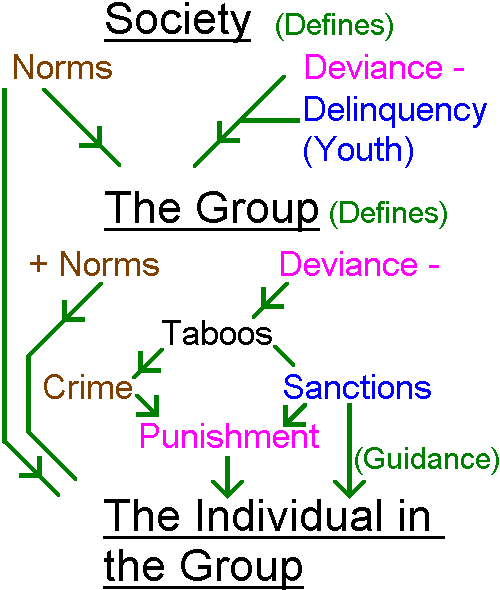
Thinking sociologically we should tell the connection between this picture and crime and deviancy. [Use OHT female in bed]

The topic area is known as crime and deviance, but the causal relationship is that first you must know what is deviant in order to find out what is a crime. In other words, what we call Law is a practice derived from culture, perhaps a consensus in an open, liberal and democratic society, but equally can be enforced by whomever has decided what is deviant and what norms need enforcing. If we look at the Aims and Objectives...
Aim of Lesson:Understanding the basics of Crime and Deviancy Statement:Deviancy comes before crime via cultural norms and the generation of taboos and sanctions: thinking sociologically not legally. Objectives:(The students will be able to demonstrate that:) This lesson we learn that:
|
There are some envelopes available with examples: discuss in pairs why, in our culture, these might be deviant or not.
These examples all show that what is deviant changes. We can see that what is right and wrong is not at least always based on an absolute but what is considered right and wrong. This is always what the group is telling the individual.
We then have the more interesting situation of the group within the bigger group. The biggest group is society, but there are groups within who may have their own norms, and individuals come within them. One of the biggest groups within the bigger group of society is youth, and certain youth groups have their own norms and sanctions amongst themselves.
When young people deviate from the norms of society a special word is given: delinquency. Now we have to be careful here as we are getting into psychological and moral overtones: however, what we are doing is reporting another social norm, that somehow young people who do not conform are delinquent.
So what we are looking at here is public definitions of what is right, and acceptable, and what is wrong, and unacceptable. What is right is the norm, and what is wrong is deviance. When something is wrong, and unacceptable, society may define the wrong as a crime, and take sanctions.
So the exact mirror of deviance and its collective means of control is the norm. Norms are derived from culture. Culture is about communication or a social conversation about ways we make meaning and organise our lives meaningfully. When the social conversation changes, norms and definitions of deviance change.
At this point, in your own way, do a quick diagram showing causal order consisting of labels and perhaps straight or curving lines or arrows about:
This was a diagram I created myself:

The functionalist perspective is where, in sociological understanding, society finds an equilibrium of commitment of its individuals and various groups to it, and this includes the existence of deviance and crime. It sees some deviance and crime as normal and even acceptable. Let's do a counterfactual thought experiment. Let's do as Emile Durkheim did and imagine a society of saints, where everyone is so good that there is nothing like what we would call crime. The nearest equivalent is a strict Islamic society.
Discussion points:
This makes the point that punishment is always relative. In a perfect society, where we follow the same norms, being slightly deviant might bring about swift punishment. Today this country along with all Western countries pursues a policy of minimum punishment for a crime consistent with justice. What constitutes justice is, once again, a matter of social agreement. Most punishment exists where physical harm takes place, and where there is loss of the means of self-support and independence.
The functionalist says that deviance is positive because it is a safety valve and a warning device.
There is one claimed yet very large safety valve in contemporary society, an activity regarded as deviant but, so its advocates claim, a preventer of greater crime? What might this be? It is pornography: its users are considered deviant, but for the most part it carries no penalty.
So how much deviance (and not just the above example) can there be? In fact a mature society is one where there can be plenty of deviance and toleration, giving little in the way of punishment. A pluralist society reduces its norms down to a minimum and welcomes diversity. This is why, therefore, punishment is minimal consistent with justice, because norms in an individualist society are relaxed. Usually the test is whether it does other people harm whether deviance carries punishment
The question is how well such a society functions as a single culture: this is the debate around multiculturalism and whether there should be one general uniting culture. Remember a culture to work must have norms and therefore deviance and some sanction against deviance.
Functionalism is not the only analysis. It has been our way in to this topic. The idea of a subculture - a group whose norms differ from the norms of society - is best understood within a structural analysis, and there is also an interactionist approach of labelling, where if you give a dog a bad name it will behave badly. But I suggest that the way into this topic is the functionalist analysis and the others are for another day.
Let us reconsider the person who, er, wants to stay in bed all day.

The Chancellor of the Exchequer has told us that (according to the Protestant Ethic) it is good to work. People who stay in bed in the sunlight are considered deviant.
Adrian Worsfold
Note that this script was for my revision beforehand. It was in front of me on the day for referral like the lesson plan but I spoke to the students and not from this.